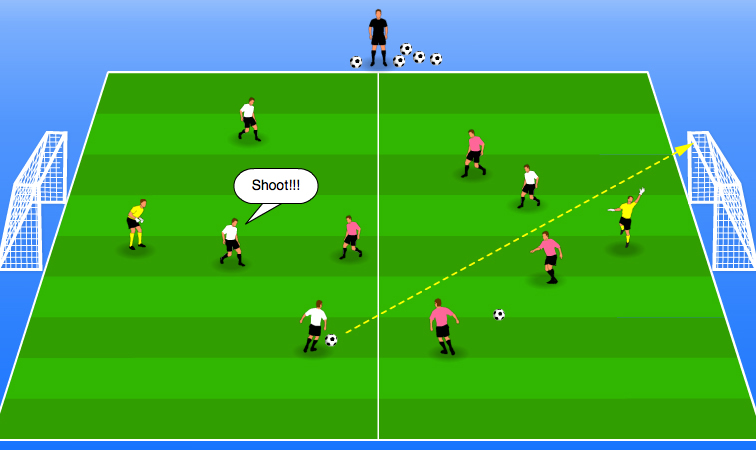Conditioned Match - Long Range Shooting
- Author: Ian Knapp
- Age Group: U9 to U17+
- Time: 30 minutes
Introduction:
This conditioned match, on a short pitch, focuses on long range shooting and includes an overload of attacking players locked into their own halves, allowing lots of opportunities to shoot from range. Once consistent success is being achieved, the game moves into a "normal" match, with the players able to move freely around the pitch.
Setup:
- Short football pitch - base the length on the age / ability of your players. They should be able to hit the target from several yards inside their own half.
- Play 4v4 + GK
- Each team has 3 players locked into their defensive half with their goalkeeper. These players are shooting at the goal in the opposite half.
- Each team has one player locked into the opposition’s half to follow up shots and pressure the opposition players.
- Coach has a number of footballs at the side.
Rules:

- Regular rules of football except players are locked in whichever half they started in.
- Players scoring from their own half get 3 points.
- If the lone striker follows up a shot to score they get 2 points.
- If the lone striker scores a regular goal from a pass out of their own half they get 1 point.
Progression:
- Remove the positional restrictions and play a “normal” 4v4 game.
- 2 points if a goal is scored from your own half.
Coaching Points (FA's 4 Corners):
| Technical | Psychological |
|---|
- Principles of play - width and depth when in possession / narrow and compact when out of possession.
- Early shot when keeper is unbalanced.
- Body shape when shooting (don’t lean back)
- First touch to take the ball where you want it.
- Look up and pick your spot for your shot (where is the GK? Shot placement). Can you go right into the corners?
- Shot type - from distance probably power (laces) or curled (instep).
- Which surface of the foot are you using to strike the ball?
- Weight and accuracy of passing / crossing from servers.
- Body shape when receiving the pass.
- Movement of striker to “lose your marker”.
- Following in from the lone striker in the other half to pick up the rebounds.
|
- Communication between team mates.
- Decision making - type of shot, when to shoot.
- Confidence to try again if a shot is missed or a poor touch is taken.
- Competitiveness - how does the competition against the other team motivate or distract players? Avoid “rushing” things but play with pace still.
|
| Physical | Social |
|---|
- Agility and body shape when receiving the ball and getting into shooting positions.
- Power in shot to beat goalkeeper.
- Balance when receiving the ball.
- Speed and pace to get to the ball quickly.
|
- Working as a team
- Encouraging others and not being negative
- Communication
- Have fun!
|